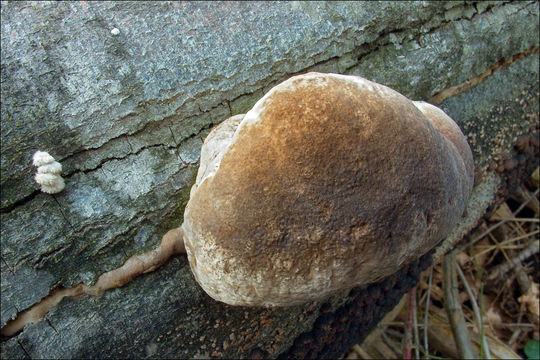Image of Phellinus igniarius (L.) Quél. 1886

Description:
Slo.: vrbov puta - syn.: Ochroporus cinereus (Niemel) Fischer, Phellinus alni (Bondartsev) Parmasto, Ochroporus ossatus Fischer, Fomes igniarius (Fr.ex.L.) Gillet - Habitat: Soa river shore, mixed forest (Pinus sp. and Picea abies dominant), south oriented slope, calcareous ground (conglomerate), humid air, sunny and relatively warm place, exposed to direct rain, average precipitations ~ 3.000 mm/year, average temperature 8-10 deg C, elevation 400 m (1.300 feet), alpine phytogeographical region.Substratum: fallen trunk of Fagus sylvatica in its initial stage of disintegration and massively infected also with Schizophyllum commune and Hypoxylon fragiforme.Comments: Phellinus igniarius (group) is without doubt the most difficult 'species' for determination of all members of genus Phellinus (Ref.3 and 4). It is extremely variable morphologically, but also microscopically traits are variable and barely sufficient to separate several taxa of this group (P. cinereus, P. igniarius s.str., P. alni). Several authors do not recognize fully these taxa. Antioxidative and anti-cancer effects of Phellinus igniarius extracts have been observed..There is no microscopy for this find; hence the determination is uncertain. However, young sporocarps of Phellinus igniarius often have roundish shape with rounded inflated pileus margin like this find. Dark (reddish) brown, woody and concentrically layered trama, pores and pileus surface and color correspond reasonably well to Phellinus igniarius, or, at least, this is the best fit I was able to find.Regarding substratum Salix is the most common for this species, but it has been found also on many other broadleaved trees. However, Fagus sylvatica is not mentioned in the literature available to me. This sheds some additional doubts in this determination.Growing solitary. 5% KOH on trama, pileus surface and pore surface dark-brown to almost back reaction. Pileus was woody/cocky, but not very hard to cut. (still young?).Ref.:(1) L. Ryvarden, I. Melo, Poroid fungi of Europe, Synopsis Fungorum 31., Fungiflora (2014), p 321. (2) J. Breitenbach, F. Kraenzlin, Eds., Fungi of Switzerland, Vol.2. Verlag Mykologia (1986), p 260. (3) G.J. Krieglsteiner (Hrsg.), Die Grosspilze Baden-Wrttembergs, Band 1., Ulmer (2000), p 455.(4) A. Bernicchia, Polyporaceae, s.l., Fungi Europaei, Vol. 10., Edizioni Candusso (2005), p 412.
Included On The Following Pages:
- Life (creatures)
- Cellular (cellular organisms)
- Eukaryota (eukaryotes)
- Opisthokonta (opisthokonts)
- Nucletmycea
- Fungi (mushrooms, lichens, molds, yeasts and relatives)
- Dikarya
- Basidiomycota (basidiomycete fungi)
- Agaricomycetes (Mushroom-Forming Fungi)
- Hymenochaetales
- Hymenochaetaceae
- Phellinus
- Phellinus igniarius
This image is not featured in any collections.
Source Information
- license
- cc-by-nc-sa-3.0
- copyright
- 2017 Dr. Amadej Trnkoczy
- photographer
- Dr. Amadej Trnkoczy
- original
- original media file
- visit source
- partner site
- CalPhotos
- ID


